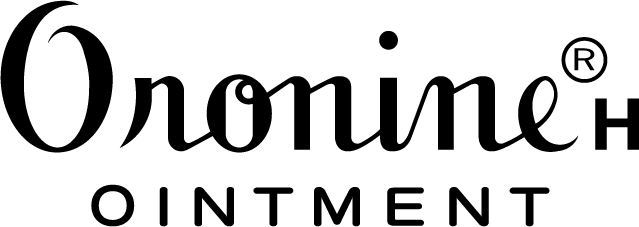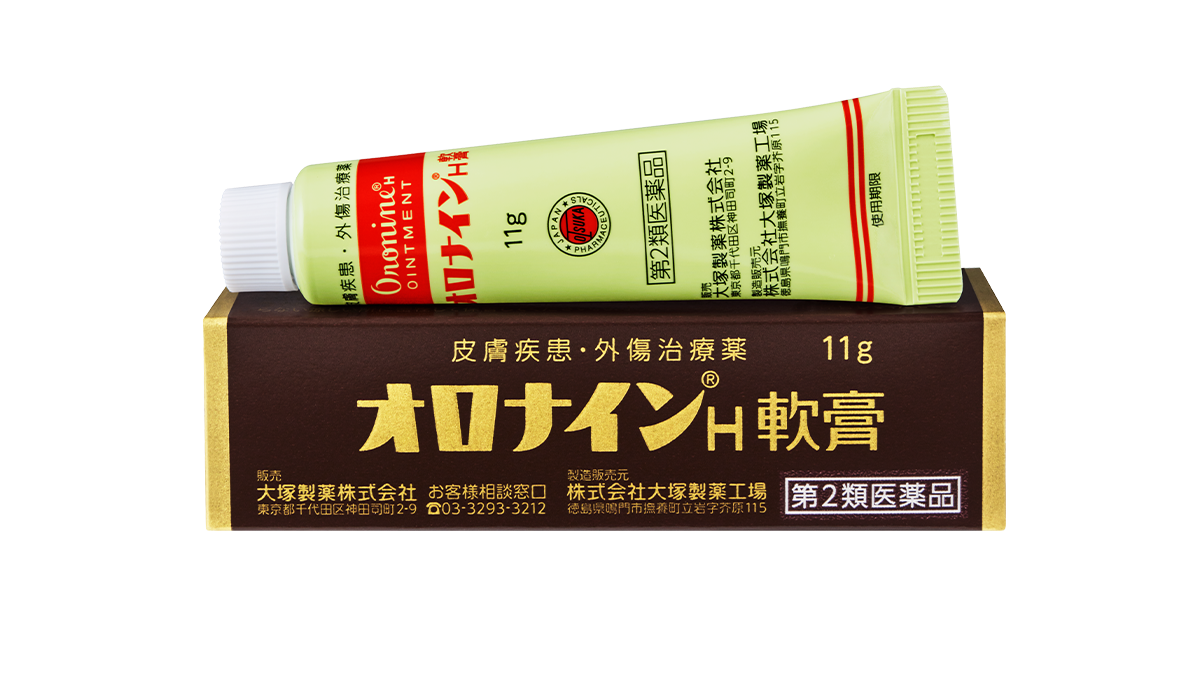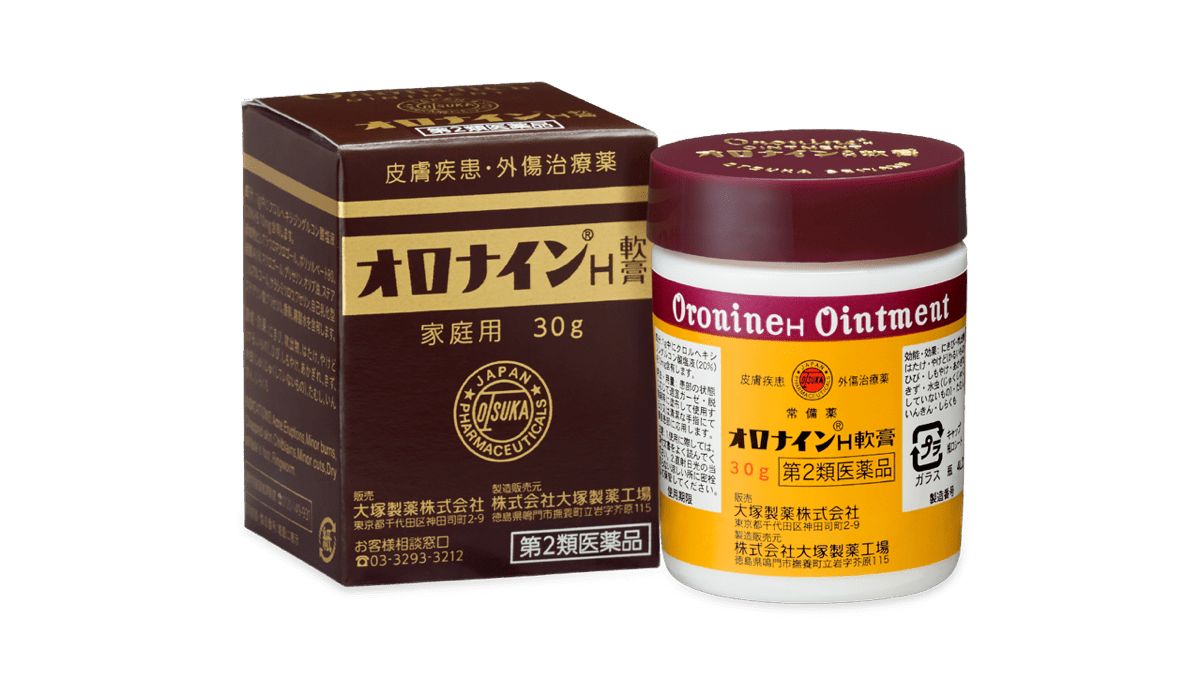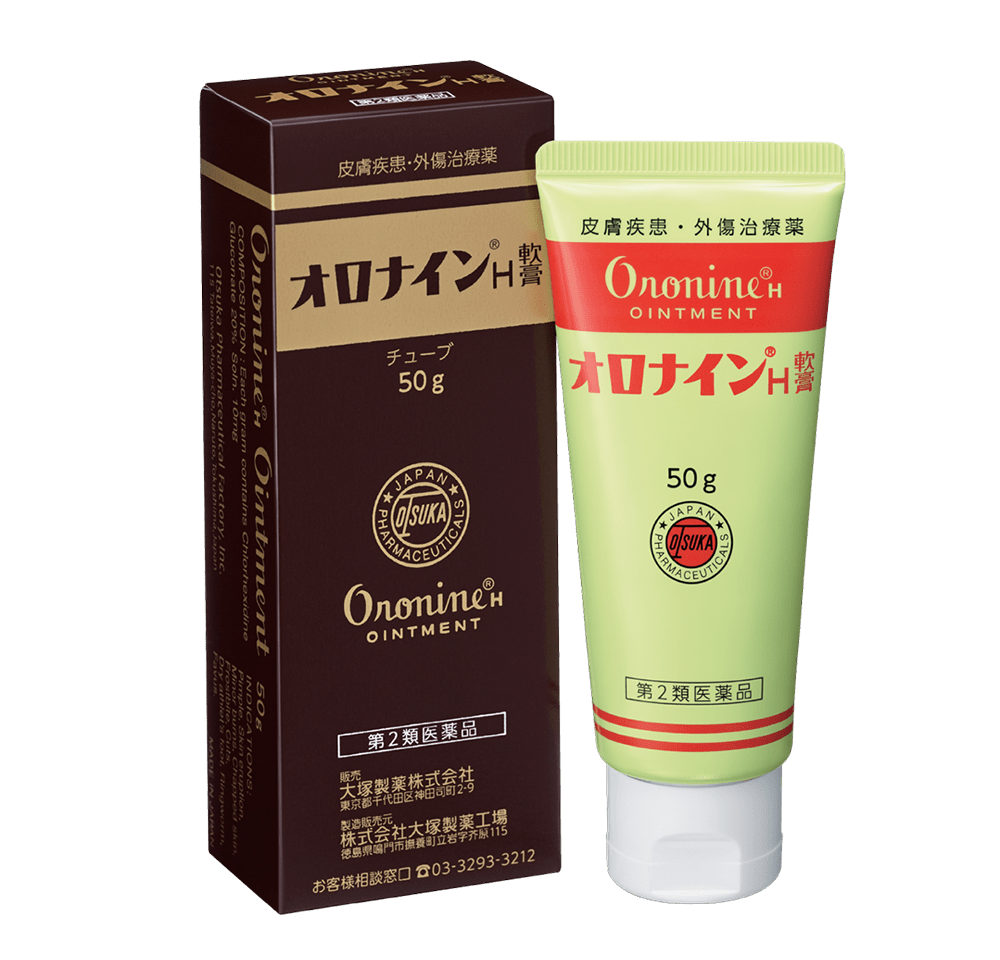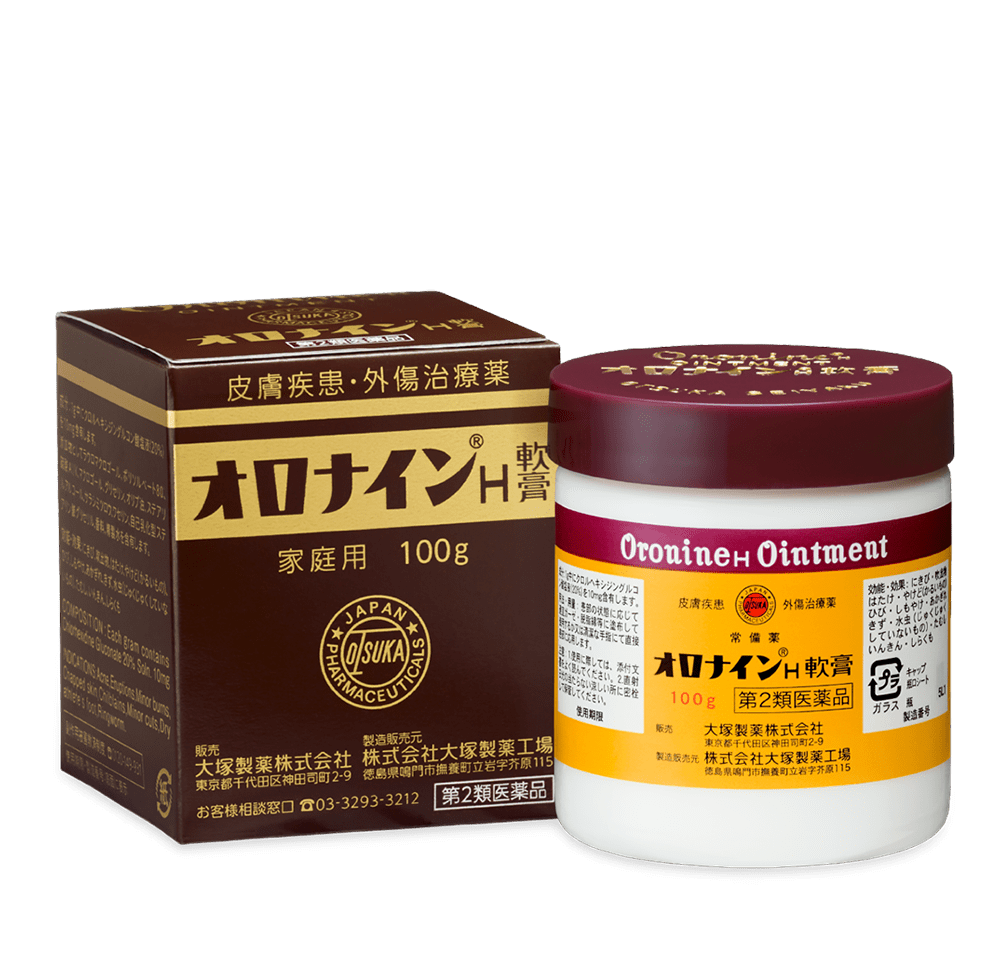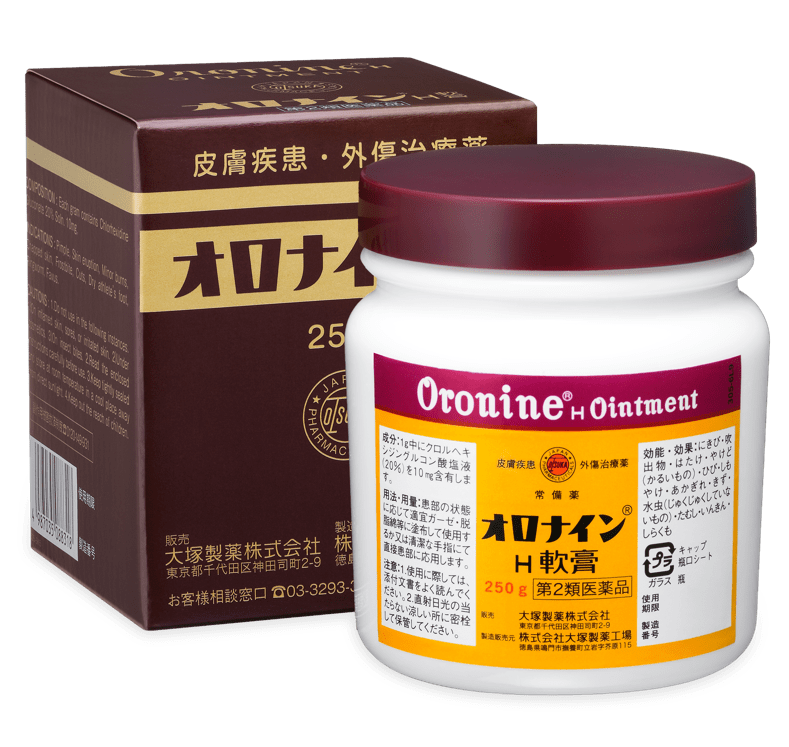Oronine - Launched from
Tokushima in 1953
"I burned myself on the teapot." "Put Oronine on it." "I fell down and skinned my knee." "There's Oronine in the medicine cabinet."
If you are Japanese, this probably sounds familiar, bringing you back to your days as a child, when cuts and scrapes were a near-daily occurrence.
"Oronine Ointment," the medicine mentioned in so many such households, was born in a small pharmaceutical factory in Naruto City in Tokushima Prefecture.
Before World War II, Otsuka Pharmaceutical Factory, Inc., which was founded by Busaburo Otsuka in 1921, made bulk ingredients for the pharmaceutical industry using magnesium chloride obtained from the salt industry in Naruto.
After the end of the war, Otsuka Pharmaceutical Factory started manufacturing not only bulk materials, but also its own pharmaceutical products – injection solutions – and expanded the scale of its operations because of the surge in demand caused by the Korean War.
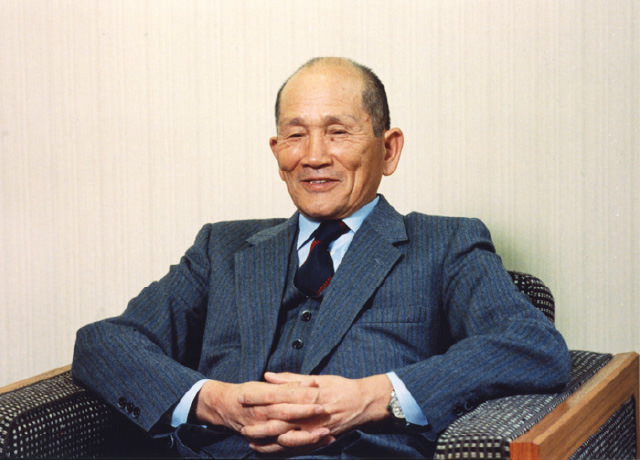
Masahito Otsuka, former President and CEO of the Otsuka Group companies.

The residence and office of Busaburo Otsuka, now located inside Otsuka Pharmaceutical Factory's premises in Naruto City in Tokushima Prefecture.
However, it was clear that, with injection solutions and distilled water as Otsuka’s only main products, business would be much tougher after the end of the demand due to the Korean War. Masahito Otsuka, who had originally joined his father’s business as the eleventh employee, took the helm of Otsuka Pharmaceutical Factory in 1947, and was struggling to develop new products when he heard about something from Mitsui & Co.
An American company, Oronite Chemical, had discovered a new disinfecting agent; what about trying to make a product using that?
But what could it be used in?
Masahito thought of ointments.
At the time, the over-the-counter drugs Mentholatum (""Menturm"" in Japan) and penicillin ointments were hit products, and Masahito thought that sales would be more stable with these kinds of products. Masahito asked three professors at Tokushima University to develop a product for Otsuka.
The new product was ready for sale in 1952, and was marketed the following year, in 1953.
Otsuka Pharmaceutical Factory's long-awaited first original product was christened "Oronine Ointment," after the name of the company manufacturing the raw material.
Bold Marketing Strategy
Oronine Ointment was therefore the result of a joint collaboration between industry and academia. However, unlike the products marketed by large pharmaceutical companies, brand recognition was poor – at first.
Otsuka therefore engaged in various sales and promotion activities in order to teach people about Oronine and get them to use it.
For example, in the year it was launched, Otsuka announced in its newsletter targeted at hospitals, the "Otsuka Pharmaceutical News," a plan to hold a "Miss Nurse Contest" and the contest was held.
Then, the following year, Otsuka sent a marketing truck on a nationwide tour, something that was extremely rare at the time.
During the first year, Otsuka’s president traveled for 26 days out of every month, visiting major hospitals across the nation, relentlessly promoting Otsuka's first original over-the-counter medicine.

Otsuka sent a marketing truck on a nationwide tour to increase "Oronine Ointment" brand awareness.
Sales grew steadily, reaching 30 million yen a month, but then plateaued. Otsuka also began hearing complaints from customers saying they didn’t like the way it smelled.
To solve the problem of flattening sales, Otsuka came up with a plan to distribute free sample packets containing 2.5 g of ointment to children in kindergartens and elementary schools nationwide (Note 1). This was an unprecedentedly bold move for the time.
The formula was also improved to eliminate the unfavorable smell and this, combined with the free sample distribution strategy, though costing more than the sales of the product, was successful: from 1957 on, sales of "Oronine Ointment" resumed their rapid rise.
Masahito said that "The best form of promotion is the product itself; if the product is used just once, that is more effective than ten advertisements." This one move turned a crisis into an opportunity.
* Note: Under the current Pharmaceutical Affairs Law, such promotional distribution is not allowed.
Marketing - Communicating the Brand
In addition to the promotion of sales to hospitals and the marketing truck and free sample distribution campaigns, Otsuka also marketed Oronine Ointment aggressively in the media.
Otsuka placed advertisements in newspapers and magazines, and enlisted Keiji Sada and Keiko Kishi, who had starred in the movie version of the radio drama "Your Name Is...," which was hugely popular at the time, to sell Oronine using the catch phrase "Your Name Is Oronine."
In the radio program "Daimaru Racket – Humorous Street Recordings," a Japanese stand-up comedy duo who performed using the stage names Nakata Daimaru and Nakata Racket made audiences laugh with a clever back-and-forth comedy routine about Oronine.

The character that appeared in the very first television commercial. These commercials included scenes showing Oronine being used by children who had fallen down and hurt themselves.

"Tonma Tengu," starring Kon Omura, was a live commercial read by the performer during the program. Kon Omura also played the character "Oronamin C."
1953, the year Oronine Ointment was launched, was also the year that television broadcasting started in Japan.
The first television commercials were broadcast live by performers during the programs.
In 1959, Otsuka sponsored the television program "Tonma Tengu," starring Kon Omura, followed by "Kotohime Shichihenge," starring Yoko Matsuyama, and "Uchi No Mama Neechan," starring Tengai Shibuya and Meiko Nakamura, and also aired commercials featuring Chieko Naniwa, Yoshiko Kayama, and Yuko Natori.

Yoko Matsuyama, who starred in the program Kotohime Shichihenge, which first aired in 1960, also later appeared on Bon Curry packaging.

Enamel billboard featuring Chieko Naniwa.
Then, starting in 1963, Otsuka advertised Oronine using enamel billboards. These were put up by salesmen as part of their job, and are now greatly prized by collectors.
Chieko Naniwa, whose real name was Kikuno Nanko, appeared on these enamel billboards and later in television commercials for Otsuka. People who found her real name afterwards laughed, noting wryly that it was an interesting choice (because in Japanese the family name "Nanko" sounds to mean "Ointment" and the first name "Kikuno" sounds to mean "Really works").

Yoshiko Kayama, the face of Oronine from 1973 to 1982.

Yuko Natori, the face of Oronine from 1982 to 1996.
The long-running television ad campaign featuring Yuko Natori ("Oronine works here, too"; "Japanese hands know it.") ran for 14 years, and firmly entrenched Oronine in consumers' consciousness.
In 2003, the 50th anniversary of Oronine's market launch, Otsuka sold a limited quantity of Oronine Ointment in 50th anniversary commemorative packaging, and also sold "Oronine Solution*", a spray-type disinfectant solution that was the first new version of "Oronine" product in 50 years. A television commercial for Oronine Solution featuring "Crayon Shin-chan" was targeted at young mothers.
Commercials for Oronine Ointment aimed at families featured the famous Japanese cartoon character Chibi Maruko-chan.

From 2006 to 2009, commercials for Oronine featured the famous cartoon character Chibi Maruko-chan.

Part of the ongoing "praise your working hands" advertising campaign featuring "working hands," which started in 2009.
Since 2009, marketing communication has targeted a younger generation, with TV commercials focusing on hardworking hands, as well as the "shiri100" campaign on Oronine H Ointment's official social media platform.
* Note 2: Liquid Oronine was discontinued in 2017.
Image Consistency
Oronine Ointment has been on the market for more than 50 years. Although the original packaging unfortunately has not survived, the design has hardly changed.
Otsuka Pharmaceutical often chooses to preserve the brand image that existed when the product was launched, not only for Oronine, but for other products as well. This is because Otsuka believes that, although the people who sell the products may become a little tired of seeing the same packaging, if the product image is changed too frequently, it might be confusing to customers.

A commemorative package of Oronine, which was marketed in limited quantities in 2002 to mark Oronine's 50th anniversary.
Although the product name was changed from "Oronine Ointment" to "Oronine D Ointment" in 1969, and then to "Oronine H Ointment" in 1972, these changes reflected differences in the principal ingredients. For example, the "H" in "Oronine H Ointment" stands for "hexidine," referring to chlorhexidine gluconate, the principal ingredient.
Oronine is used by children for scrapes and cuts, by mothers for chapped and cracked skin, by fathers for athlete's foot, by teenagers for acne, and for many other uses.
Oronine is in this way passed from mother to daughter to granddaughter, the history of the family telling the story of Oronine down through the generations.
* This article was written based on information that first appeared on the "Comzine" web site (NTT Comware).

"Oronine H Ointment" comes in 30g, 100g
and 250g jars, a 11g and 50g tube.
Indications: acne, pimples, pityriasis simplex, minor burns, cracked skin, chilblains, chapped skin, cuts, athlete's foot (non-oozing), ringworm, jock itch, tinea
